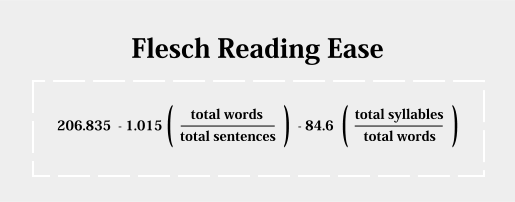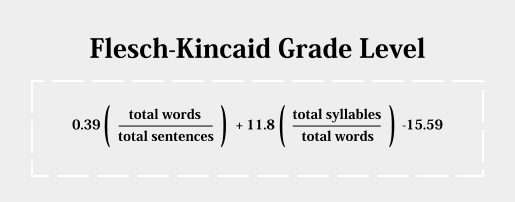Flesch readability scores are probably the most commonly cited and used of all readability scoring formula. But, what actually are Flesch (1948) and Flesch-Kincaid (1975) readability scores? And what do the scores really mean?

What is a Flesch Reading Ease score?
a score of 70-80 is equivalent to school grade level 7
Flesch Reading Ease (1948) is a readability test. The score on the test will tell you roughly what level of education someone will need to be able to read a piece of text easily.
The Reading Ease formula generates a score between 1 and 100 (although it is possible to generate scores below and above this banding). A conversion table is then used to interpret this score. For example, a score of 70-80 is equivalent to school grade level 7 and should be fairly easy for the average adult to read.
The Flesch Reading Ease test originated from research in the education sector from a need for teachers to choose texts appropriate to the reading level of their student. Yet, its use has always been far more wide-ranging. In the late forties, the creator of the measure, Rudolph Flesch, worked as a consultant with the Associated Press to try and help them improve the readability of newspapers. Now, the Flesch Reading Ease is used by digital marketers, research communicators and policy writers among to help them assess the ease by which a piece of text will be understood and engaged with.
And what about the Flesch-Kincaid Grade Level (1975)?
In the mid-seventies, the US Navy were looking for a way of measuring the difficulty of technical manuals used by Navy personnel in training. A challenge in using the Flesch Reading Ease measure is that test results are not immediately meaningful. To make sense of the score requires the aid of a conversion table. So, the Flesch Reading Ease test was revisited and, along with other readability tests, the formula was amended to be more suitable for use in the navy. The new calculation was the Flesch-Kincaid Grade Level (1975).
For the Flesch-Kincaid Grade Level test (1975), grade level classifications are based on the attainment of participants in the norming group on which the test was trialled. The grade represents norming group participants’ typical score. So, if a piece of text has a grade level readability score of 6, this is equivalent in difficulty to the average reading level of the norming group who were at grade 6 when they took the test.
How do the tests work?
If maths is not your thing, look away now.
The mathematical formula underlying the two tests look like this:


For many of us, the sight of a mathematical formula is rather scary. But, the building bricks that make up the formulas are actually very simple.
The formulas are based on two factors:
- sentence length as judged by the average number of words in a sentence
- word length as judged by the average number of syllables in a word.
The rationale here is straightforward. Sentences that contain a lot of words are more difficult to follow than shorter sentences. Just read James Joyce’s Ulysses if you don’t believe me. Similarly, words that contain a lot of syllables are harder to read than words that use fewer syllables. For example, the sentence ‘It was a lackadaisical attempt’ is more difficult to read than ‘It was a lazy attempt.’
Making sense of the results
the weightings differ between formulas resulting in different readability scores for each test
Both the Flesch Reading Ease and Flesch-Kincaid Grade Level tests are calculated on the same units: sentence length as judged by the average number of words in a sentence, and word length as judged by the average number of syllables in a word. But, the weightings differ between formulas resulting in different readability scores for each test.
Flesch-Kincaid Reading Ease: For Flesch-Kincaid Reading Ease, the higher the reading score, the easier a piece of text is to read. Note that this differs from the majority of readability scores where a lower score is easier. To make sense of a Reading Ease score you can use a conversion table to translate their score into a grade level score. For example, a reading score of 60-70 is equivalent to a grade level of 8-9 so a text with this score should be understood by 13-15 year olds.
Flesch-Kincaid Grade Level: As stated in the label, the score that is generated by the Flesch-Kincaid Grade Level is equivalent to the US grade level of education that the reader would require to be able to understand that piece of text. So, a piece of text with a Flesch-Kincaid Grade Level score of 8 should be readable by those who have reached the 8th grade of schooling (aged 13-14).
So, which test should I use?
Flesch Reading Ease is the classic of the readability tests
Flesch Reading Ease is the classic of the readability tests. Published in 1948 it was the first of a glut of mid-20th-century readability tests with the Gunning-Fox and Spache both appearing a few years later in 1952. The original and longest established readability test, the Flesch Reading Ease it is used widely by government departments and researchers. Given its durability, Reading Ease is seen by some as a safer bet in terms of generating reliable and valid readability scores.
A possible limitation of the Flesch Reading Ease measure is that a conversion table is required to understand the results of the test. Hence, the reason that the simplified version of the Flesch test formula, the Flesch-Kincaid Grade Level measure, was created. The benefit of the Flesch-Kincaid Grade Level formula is that the results are easy to interpret with the score matched to the grade level required to read the given piece of text.
When is Flesch-Kincaid most useful?
Flesch-Kincaid readability tests are useful any time you want to measure how easily people can understand a piece of text. Text intended for readership by the general public should aim for a grade level of around 8. So, that’s a Grade Level readability score of around 8, or a Reading Ease score of around 60.
What you might use readability testing for depends on your sector.
You may be:
- a teacher trying to choose textbooks for your class
- a marketer advertising a product
- an author editing your novel
- a researcher trying to communicate your findings to a non-specialist audience
Whatever you are writing, readability scores can give you valuable insights into how easy your text is to understand by your intended reader, in turn, influencing the extent to which people engage with and take on the message you want to communicate.
